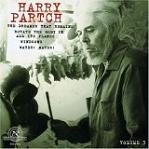Gems and curios comprise Volume 3 of CRI’s Harry Partch collection (reissued by New World). First the gems. The Dreamer that Remains was the composer/instrument builder/maverick theorist’s final composition, conceived for the film with the same name that documents Partch’s life story and music making. The opening measures quickly establish Partch’s unique microtonal language with ceremonial percussive whacks, the wheezing Chromelodeon (kind of a dented harmonium), shimmering plectrum sounds, and chant-like vocal passages. Overall, the score is more darkly lit and reflective, but interjections of spoken text (Partch’s usual hobo tales and childhood events) lighten things up. However, the dry sonic ambience compounded by overly close microphone placement compromises the Partch instruments’ belly-shaking resonance and overtones.
Windsong also derives from a film soundtrack. Although it incorporates 10 instruments, no more than four are ever heard together. The music is constructed in brief modules that follow each other in the manner of a filmmaker cross-cutting between plot lines. Partch plays all the instruments (via overdubbing), displaying an impressive fast mallet technique and getting a warmer sound out of his Adapted Viola than subsequent Partch ensemble players do.
Now the curios. During rehearsals of the music-theater work Revelation in the Courthouse Park in 1961 at the University of Illinois, Partch was approached to flesh out one of the scenes with more music for use at the National Collegiate Gymnastics Championships. The result is a strange hybrid of pure Partch and fuzzy marching band ditties laced with texts that might be subtitled “The Rime of the Ancient Cheerleaders”. Partch didn’t think highly of his 1961 large-scale satirical farce Water! Water!, although its broad, declamatory vocal style and frequent evocation of flagwaving march rhythms and operetta melodies might come off less heavy-handed when experienced in a theatrical (as opposed to audio only) context. Some of the non-verbal vocal effects foreshadow techniques that Meredith Monk would further explore 20 years later.
Listeners new to Partch will glean a more complete and musically satisfying taste of his singular aesthetic from such works as U.S. Highball (available on Volume 2 in this series) or his magnum opus The Delusion of the Fury (available from Innova). Still, all serious Partch specialists will value this release, for which Partch biographer Bob Gilmore contributes superlative booklet notes.
































